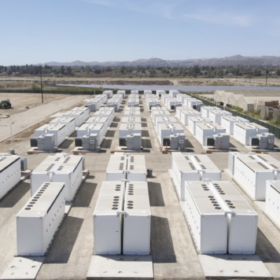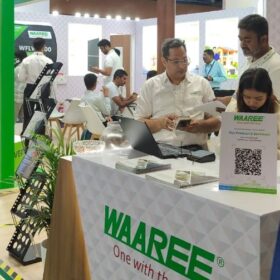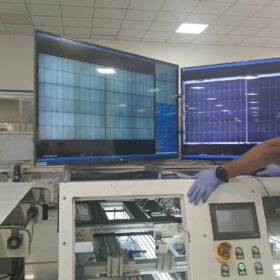“We are learning to live with the pandemic,” said solar manufacturers and developers at a Renewable Energy India Expo session moderated online by pv magazine publisher Eckhart Gouras.
For manufacturers, the Covid-19 pandemic brought challenges including supply chain disruption, sudden migration of trained labor and machine maintenance problems – which were also affected by supply chain turbulence. As production restarts, manufacturers face the headache of maintaining safe working distances between employees.
“There are a lot of people working very closely [to each other], such as in packaging or busbars,” said Hitesh Doshi, chairman of the All India Solar Industries Association and chairman and MD of Indian solar manufacturer Waaree Group. “Maintaining at least two meters of distance between two people working together on the same machine is a challenge, as the machines were not designed that way.”
Disruption to the supply of raw materials and spare parts have also hampered the Indian solar industry, which imports almost 80% of its components from China.
Chiranjeev Singh Saluja, MD of solar manufacturer Premier Solar, said: “The ripple effects of [the] Covid-19 pandemic are difficult to model and assess because global businesses can begin to mitigate supply chain distributions. What we need to do is to find alternative supply-chain scenarios – especially in the case of the virus emerging in different territories – and activate pre-approved parts or raw material substitutions.”
South Korean solar module and electrical power products manufacturer LS Electric has accelerated automation in its factories to minimize problems arising from the spread of the novel coronavirus among its workers. Henry Choe, country head of LS Electric India, said: “Imagine one of our laborers tested positive. This means we need to shut down all the factories. It will eventually be affecting our productivity. Factory automation enables us to operate our factory with minimal human interference. Of course, there are specific areas that still need to be handled by humans. One of the new technologies we have inducted is the internet of things, helmet-based inter-inspection for our in-factory acceptance test.”
Chinese solar manufacturer JinkoSolar had to find a way to keep production running during a period of peak demand despite being without 60-70% of its workforce. Manish Narula, senior director of business development (India) at JinkoSolar, said: “Factories at that time were running 24/7, in several shifts. We couldn’t afford to stop for a single minute. So the team and the staff which was inside the factory had to stay in for the time there was an impact. We had to manage the continuity at the peak time with 30-40% of this workforce and could not afford [for] them to go out and allow others to get into the factory because of the spread [of Covid-19] outside.
“Gradually, when things started to normalize in China, we had certain quarantine protocols. We started allowing the outside workforce to enter, with dual safety of safe distancing and masks. So after 40-45 days of running with 30-40% of efficiency, we started getting back to the normal levels and, within two months, we were back to 100%.”
Project development
Solar project construction activity has continued but was slowed by the pandemic. “What we used to do in three months, earlier, it will now take six months,” said Pinaki Bhattacharyya, managing director and CEO of the Indian business of Canadian solar developer Amp Energy. “Unlike module manufacturing, wherein several people work in a small area, project development is done on large land parcels. Therefore, the workforce can be spread out.”
However, with the availability of labor restricted by Covid-19 lockdowns, developers are also considering automation.
Santosh Khatelsal, MD of the Indian subsidiary of German solar developer Enerparc AG, said: “While our project construction activities resumed fairly early at sites in Northern Europe, Spain and Australia, in India, construction sites were closed for the entire two-and-a-half months. In June, we were able to start them up with roughly 25-30% of the people working on sites.
“As the industry faces the challenge of migrant labor moving back, there is a need to rethink the labor dependency of construction in India, which has traditionally been the case. I think that is the awakening that the industry should try for more and more automation and not go for labor-intensive activities in construction. Try and do pre-assemblies wherever you can.”
This content is protected by copyright and may not be reused. If you want to cooperate with us and would like to reuse some of our content, please contact: editors@pv-magazine.com.









The helplessness of the Indian Industry is….. pathetic.
Whilst the 2m/6ft “COVID Rule) is definitely challenging…NOT IMPOSSIBLE; their complete surrender to the “Chinese Supply Chain” is as I said… pathetic.
This “problem” is an opportunity to “jump start” the MADE IN INDIA… FROM INGOT TO SOLAR GRID INDUSTRY.
As an example…..
A proposal submitted to PM Modi for ONE TW/YR Zero Pollution AgriVoltsics Option will require 100Nos 10GW “Ingot to Panel” Facilities in India and keep them busy for 20-30 yrs and beyond.
THE BIGGEST QUESTION IS…. IS INDIAN INDUSTRY CAPABLE OF GETTING OUT OF THEIR “LITTLE HOLES” & FACE THE FUTURE… WITH VISION, FORESIGHT AND COURAGE… !!!!